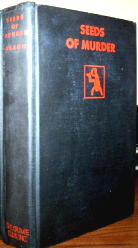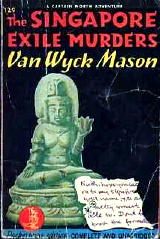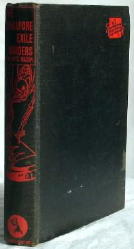Sun 5 Jul 2009
VAN WYCK MASON – The Singapore Exile Murders. Pocket 129, paperback reprint; 1st printing, December 1941. Hardcover edition: Doubleday Crime Club, 1st printing, June 1939. Hardcover reprint: Sun Dial Press, June 1940.

Widely respected for his historical fiction, Van Wyck Mason (1901-1978) is equally if not better known for his roughly two dozen book length adventures of Captain Hugh North, a American agent working for a government outfit called G-2. The first of the latter was Seeds of Murder (1930), the last being The Deadly Orbit Mission (1968).
A complete list of all Mason’s books can be found on his Wikipedia page, along with a photo and a short biography.
Thirty-eight years is a long time to be writing spy fiction, a run that I suspect few authors can match. The setting of The Singapore Exile Murders is obvious, I should think, and the date of publication (1939) is just as important — the entire city is on edge with news of the seemingly unavoidable oncoming war streaming in non-stop from Europe.
One of the more important characters in the book is suspected by being an agent for the Japanese, and the local Japanese fleet is decidedly on maneuvers, but Hitler and the events ongoing in France, Hyde Park and Czechoslovakia seem to be causing the most jitters.
From page 155 of the Pocket edition:

A lively disquiet filled North. What the devil could be going on at the other end of the cables and the radio stations? Of only one thing was he sure: The breath of war beat hot on Singapore.
Here’s another sample of Mason’s writing, this time from page 163. This scene takes place at the home of a wealthy Dutch resident of Singapore, and one of the men and women most interested in the formula for a new lightweight metal alloy that Leonard Melville, the man everyone is looking for, has discovered:
Barentse’s huge dining room was lavishly but tastefully decorated in Javanese mode. Intricately carved ceiling beams gleamed with gold leaf; faces hideous and comic looked down from scarlet-and-gilt corbels supporting them.
Malay weapons — tulwars, pikes, krises, shields and daggers — with filigrees of gold and silver were arranged in a panoply along one wall. Small censers dangled from the four corners of the room and expelled lazy spirals of fragrant smoke. Huge lamps of bronze filigree cast on the diners an ample light which was very flattering to the complexions of the women. Dozens of candles drew flashes from the gleaming silver service, and many crystal glasses were arranged in groups before each place.

Of course there beautiful women involved — two of them, in fact — and North has to balance his own search for Melville between them. (There would have been a third, but she dies early on in the book, in what was for me quite an disturbing turn of events, but I think it was Mason’s way of letting the reader know not to take anything for granted.)
North himself is very much an earlier generation’s James Bond, US style, without the same license to kill, but perhaps it was an authorization that was purely tacit. In a similar sense, he’s an agent who’s pretty much left on his own, a la Edward S. Aarons’s Sam Durell, with lots of exotic locales included in fine detail. (See above.)
After a fairly tense few opening chapters, as North’s plane is forced down in a horrendous storm somewhere en route to Singapore, the middle portion of the book is a textbook example of how to fill lots of pages with action and twist after twist without anything actually being accomplished.
The ending is a considerable improvement in comparison, but to me, the grand finale was still rather flat — not pancake style, to make a totally inappropriate simile — but neither did it push the overall effort over the top. About average, then, overall, with parts of this eve of World War II spy adventure novel that are far better than that.
July 6th, 2009 at 4:12 am
Mason once admitted that even though he had been to many of the places in the North novels during his military career he didn’t take notes at the time and relied on National Geographic for local color. Don’t know as I fully believe him.
I admit to liking the North novels despite some of their flaws. In general I think your complaint about the build up being greater than the payoff holds for many of them. One factor I really enjoyed in some of them is when North has to scrabble together his own forensics materials, making his own fingerprint powder, and even doing crude ballistics tests while investigating murder in some exotic locale.
Later the mystery element was replaced by more standard adventure and spy doings, though Himalayan Assignment (the last appearance of North’s adversary General Sam Steele, a renegade soldier) was a highpoint I thought, and most of them were above average reads.
Though they were always published in hardcovers, many of the books also appeared in the pulps. And in the 1950’s Mason rewrote and updated one or two of his earlier novels when they were reissued in paperback.
There was even a radio series, The Man From G2, and Nick Cardy tried to syndicate a comic strip, Major North (over the years North rose to the rank of Colonel). I’m surprised they were never grabbed up for a B movie series, since they had the exotic locations and fast moving stories that were favored, plus an all American hero. I was always torn between the younger Preston Foster and George Brent as North, though to be honest I always envisioned him as looking a bit like Clark Gable.
For that matter Don Sherwood’s comic strip Dan Flagg, about a Marine troubleshooter always struck me as Colonel North in all but name, merely moved over to another service.
It’s also fun to read the books from different periods and see Mason’s approach and style vary. One reason the North books lasted as long as they did was that he managed to change his approach just enough to keep them up to date for the current audience. By his last one, The Deadly Orbit Mission he was even playing off Ian Fleming a little bit, and yet from first to last North himself is a very self contained and stable presence in the books.
July 6th, 2009 at 6:29 am
This is a very enjoyable article.
I’ve only read a little of Mason. There is a review in my Joseph H. Lewis web-book of “The Spy Ring” (1938), a film version of Francis Van Wyck Mason’s novella “The Enemy’s Goal”, Argosy, May 18, 1935 (Vol. 255, Number 5):
http://mikegrost.com/lewis.htm#Ring
July 6th, 2009 at 2:50 pm
I liked the early Major North books better than the later ones, but they’re all pretty good. Mason was a fine historical novelist and evidently still popular, because once a month or so I still get comments on a blog post I wrote about him years ago.
July 6th, 2009 at 8:25 pm
David’s post reminded me that when I read a book I often have a picture of many of the leading characters in mind. I’m sure that Mason described Hugh North several times, but I’ve just realized that I don’t have a solid mental image of him.
David’s suggestions of Preston Foster, George Brent and Clark Gable are all good, but none fit my perception of him exactly.
Maybe Robert Taylor. That’s as close as I can come at the moment.
July 12th, 2009 at 7:08 am
Singapore Exile is one of the best in the series. The cover art for the dust jacket is one of the best ever which makes this probably the most collectible book in Mason’s oeuvre. After WW II I think Mason starts to focus more on the historical fiction as the later works feel like they were dashed off in a hurry just to please his publishers.
I would be interested in a reference for the National Geographic usage from Mr. Vineyard as I am largely responsible for the Wikipedia bio.
Clark Gable would have been good as North.
July 12th, 2009 at 8:08 pm
Steve
Ironically the model for Don Sherwood’s Dan Flagg was Robert Taylor (a friend of Sherwoods). Taylor crossed with Gary Cooper was also cartoonist John McClusky’s model for the James Bond strip. Taylor would have made a great North.
Gable just looked like some of the paperback cover art from the fifties and early sixties, though the later Bob Abbett covers were probably closer to either Taylor or Richard Egan.
Dave
Mason loved the covers painted for his hardcovers and wrote about the artist, but I can’t recall the fellows name without looking.
The quote from Mason was in an old Writer’s Digest article I found in college while searching the card stacks for info on Mason. I’m sorry but I don’t know what year, or if it was Writer’ Digest or something similar. I think it was Digest though.
In it Mason mentions having visited many of the locales in the North books, but said he was too busy at the time to gather the kind of detail used in the North books so like anyone else he used National Geographic as a reference.
As I remember he was taking a general shot across the bow at the Hemingway school that insisted on experience and at the “write what you know” command. Mason, both as a historical novelist and author of the North books, was suggesting it was more important to read what you were interested in and then write what you have learned.
Oddly enough Hemingway himself wrote this line in one of the incomplete Nick Adams stories:
“Everything he had ever written that was any good was made up.”
September 4th, 2010 at 5:32 pm
I tried to compare the Hugh North novels to other long running secret agent novel series by one author.
Malko Linge: 1965 to 2010 (presumed): 45 years, by Gerard De Villiers
Hugh North: 1930 to 1968, 38 years, all by Van Wyck Mason
Matt Helm: 1960 to 1993, 33 years, all by Donald Hamilton (one remains
unpublished)
Quiller: 1965 to 1996: 31 years, by Adam Hall/Elleston Trevor
Modesty Blaise (in prose): 1965 to 1996, 31 years, by Peter O’Donnell
So far based on what I have written above, De Villiers has the overall record,
while Van Wyck Mason has the record in the English language. Others more
knowledgeable may have thought of a longer series by one author.
Anyone have any information about Herbert New?
September 6th, 2010 at 8:30 pm
[…] â— Finally, a comment left by the anonymous PB210 following my review of a “Hugh North” novel by Van Wyck Mason needs some additional exposure, I […]
May 5th, 2013 at 8:39 am
Definitely Clark Gable as Colonel North; possibly Robert Taylor. Mason’s writing exhibits superb exposition and some truly striking phrases. He has such a delightful way with words that the pages of his novels turn themselves.
January 31st, 2014 at 3:31 pm
To all,
Stumbled onto this site by accident. I have been an avid Van Wyck Mason collector since I was about 12 years old and started reading mysteries and historical fiction from my Mother’s library and other sources. Now, 55 years later, I have first edition copies of all of Mason’s works, a few pulp editions with his work, and several audio recordings of Mr. Mason’s appearance on popular radio programs during his lifetime.
I understand that The Singapore Exile Murders was indeed made into a movie, and I have been searching to obtain a copy – although I am not sure if one exists. Any suggestions or information from anyone?
February 1st, 2014 at 4:00 pm
Tom
Thanks for stopping by. You’re my kind of collector!
As for THE SINGAPORE EXILE MURDERS, I can find no record that it was ever made into a movie. If you ever learn otherwise, stop back and let us know.
Steve